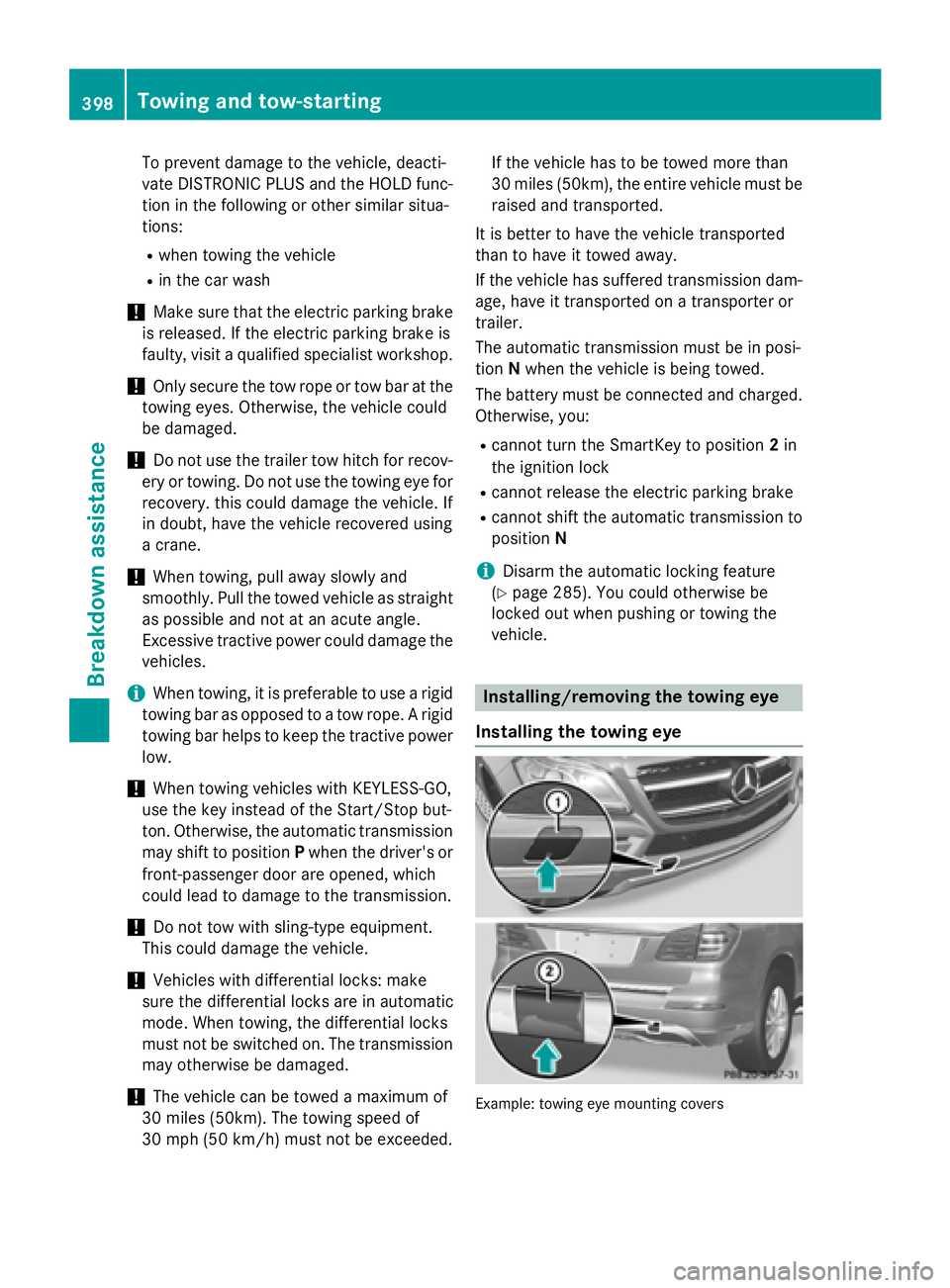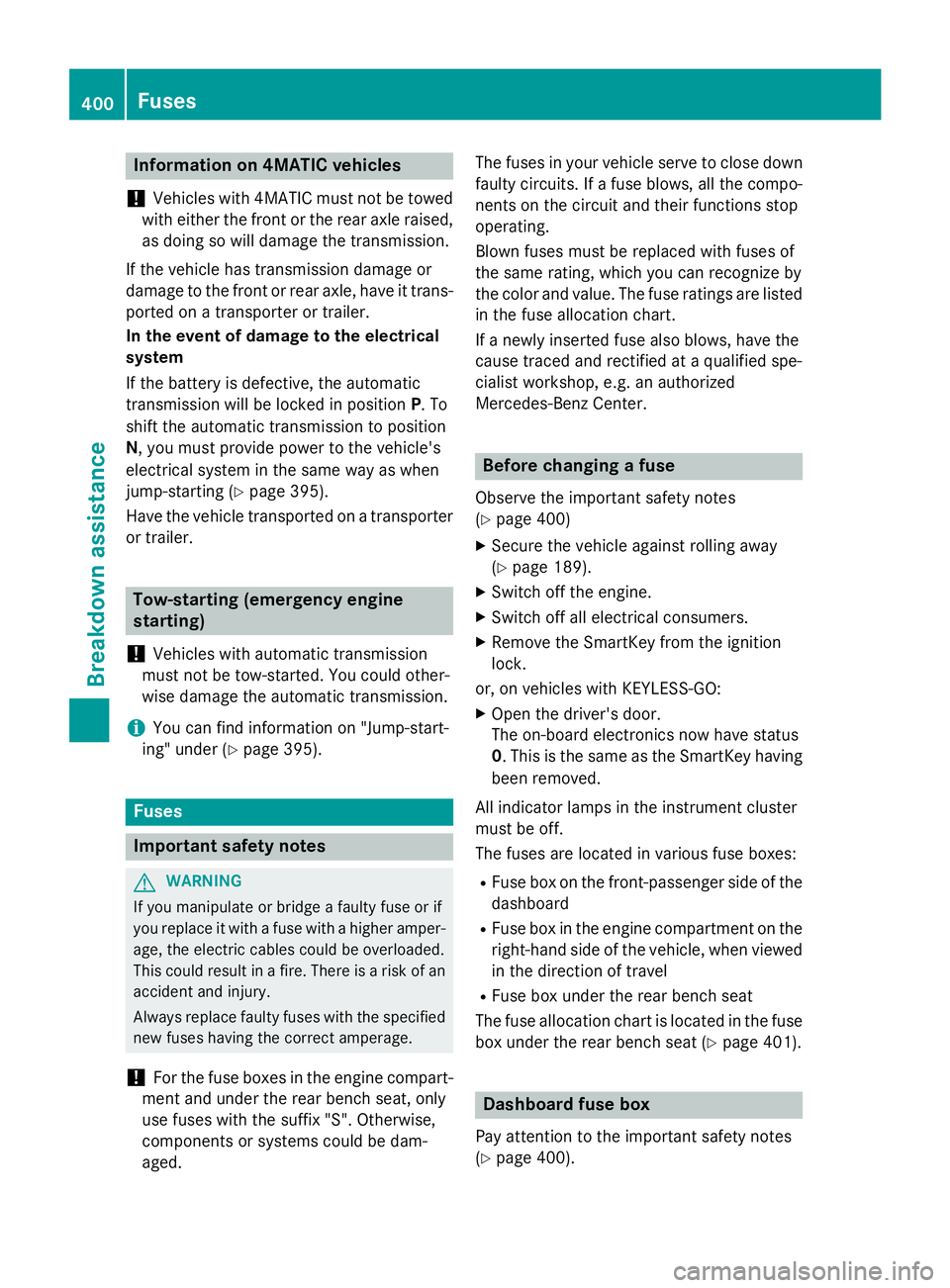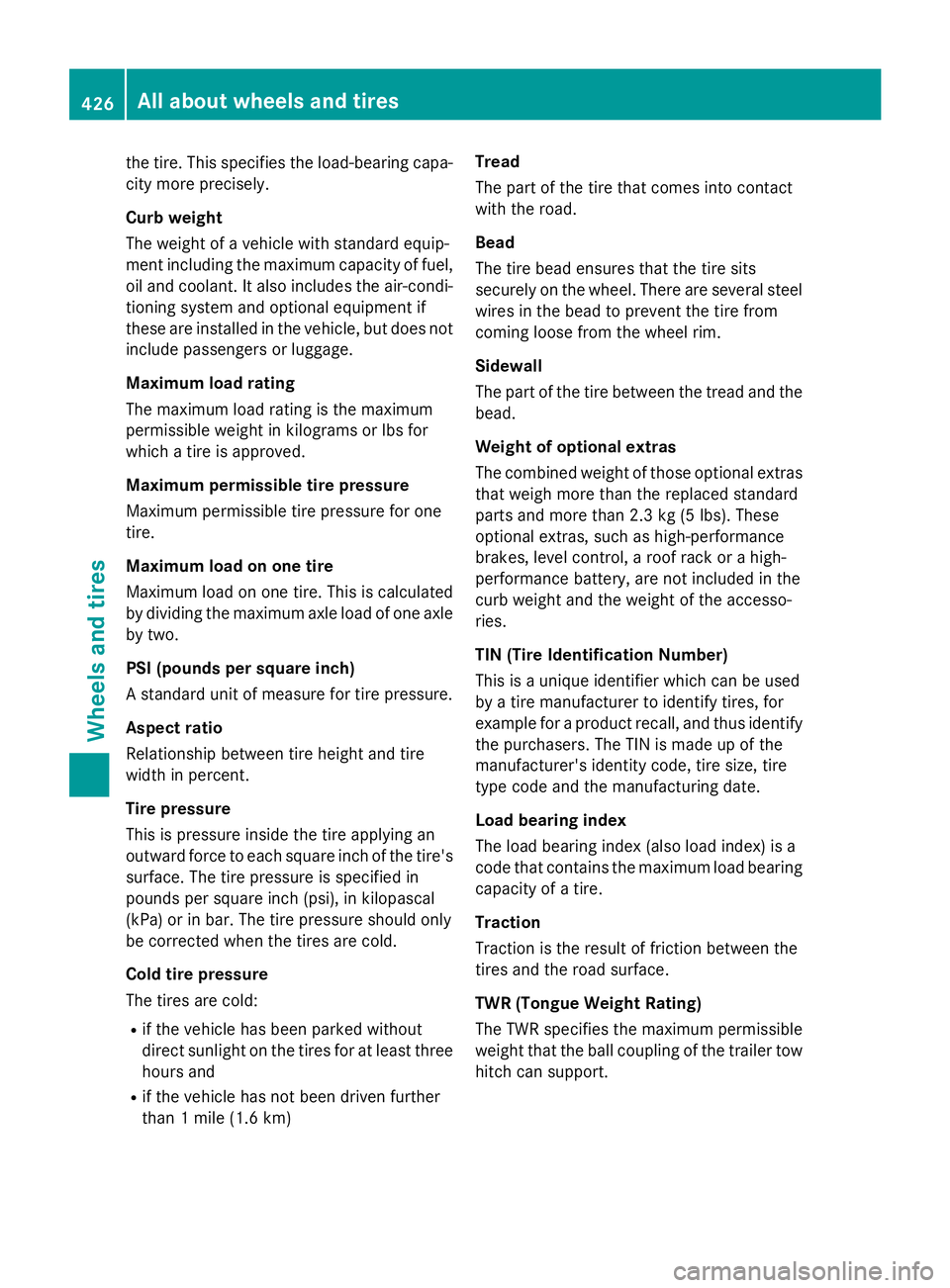Page 400 of 462

To prevent damage to the vehicle, deacti-
vate DISTRONIC PLUS and the HOLD func-
tion in the following or other similar situa-
tions: R
when towing the vehicle R
in the car wash
! Make sure that the electric parking brake
is released. If the electric parking brake is
faulty, visit a qualified specialist workshop.
! Only secure the tow rope or tow bar at the
towing eyes. Otherwise, the vehicle could
be damaged.
! Do not use the trailer tow hitch for recov-
ery or towing. Do not use the towing eye for
recovery. this could damage the vehicle. If
in doubt, have the vehicle recovered using
a crane.
! When towing, pull away slowly and
smoothly. Pull the towed vehicle as straight
as possible and not at an acute angle.
Excessive tractive power could damage the
vehicles.
i When towing, it is preferable to use a rigid
towing bar as opposed to a tow rope. A rigid
towing bar helps to keep the tractive power
low.
! When towing vehicles with KEYLESS-GO,
use the key instead of the Start/Stop but-
ton. Otherwise, the automatic transmission
may shift to position P when the driver's or
front-passenger door are opened, which
could lead to damage to the transmission.
! Do not tow with sling-type equipment.
This could damage the vehicle.
! Vehicles with differential locks: make
sure the differential locks are in automatic
mode. When towing, the differential locks
must not be switched on. The transmission
may otherwise be damaged.
! The vehicle can be towed a maximum of
30 miles (50km). The towing speed of
30 mph (50 km/ h) must not be exceeded. If the vehicle has to be towed more than
30 miles (50km), the entire vehicle must be
raised and transported.
It is better to have the vehicle transported
than to have it towed away.
If the vehicle has suffered transmission dam-
age, have it transported on a transporter or
trailer.
The automatic transmission must be in posi-
tion N when the vehicle is being towed.
The battery must be connected and charged.
Otherwise, you: R
cannot turn the SmartKey to position 2 in
the ignition lock R
cannot release the electric parking brake R
cannot shift the automatic transmission to
position N
i Disarm the automatic locking feature
( Y
page 285). You could otherwise be
locked out when pushing or towing the
vehicle.
Installing/removing the towing eye
Installing the towing eye
Example: towing eye mounting covers398
Towing and tow-starting
Breakdown assistance
Page 402 of 462

Information on 4MATIC vehicles
! Vehicles wit h 4MATIC must not be towed
wit h either the front or the rear axle raised,
as doin g so will damage the transmission.
If the vehicle has transmission damage or
damage to the front or rear axle, have it trans-
ported on a transporter or trailer.
In the event of damage to the elect ri cal
system
If the battery is defective, the automat ic
transmission will be locked in position P . To
shift the automat ic transmission to position
N , you must pro vide power to the vehicle's
electrical system in the same way as when
jum p- starting ( Y
page 395).
Have the vehicle transported on a transporter
or trailer.
Tow-starting (emergency engine
starting)
! Vehicles wit h automat ic transmission
must not be tow-starte d. You could other-
wise damage the automat ic transmission.
i You can find information on "Jump-start-
ing" under ( Y
page 395).
Fuses
Important safety notes
G WARNIN G
If you manipulat e or bridge a fault y fus e or if
you replace it wit h a fus e wit h a higher amper-
age, th e electric cables could be overloaded.
This could result in a fire. Ther e is a ris k of an
acciden t and injury.
Always replace fault y fuses wit h th e specifie d
ne w fuses having th e correc t amperage .
! For the fuse boxes in the engine compart-
ment and under the rear bench seat, on ly
use fuses wit h the suffix "S". Otherwise,
components or systems could be dam-
aged. The fuses in your vehicle ser ve to close down
faulty circuits. If a fuse blows, all the compo-
nents on the circuit and their functions stop
operating.
Blo wn fuses must be replaced wit h fuses of
the same rating, which you can recogn iz e by
the color and value. The fuse ratings are list ed
in the fuse allocation chart.
If a newly inserted fuse also blows, have the
cause traced and rectified at a qualif ied spe-
cialist worksho p, e.g. an authorized
Mercedes-Benz Center.
Before changing a fuse Observe the important safety notes
( Y
page 400) X
Se cure the vehicle against rol lin g away
( Y
page 189). X
Swi tch off the engine. X
Swi tch off all electrical consumers. X
Remo ve the Sm artKey from the ign it ion
lock.
or, on vehicles wit h KEYLE SS ‑ GO:X
Open the driver's door.
The on-board electronics now have status
0 . This is the same as the Sm artKey having
been remove d.
All indicator lamps in the instrument cluster
must be off.
The fuses are located in various fuse boxes:R
Fuse box on the front-passenger side of the
dashboard R
Fuse box in the engine compartment on the
right-hand side of the vehicle, when view ed
in the direction of travel R
Fuse box under the rear bench seat
The fuse allocation chart is located in the fuse
box under the rear bench seat ( Y
page 401).
Dashboard fuse box
Pay attention to the important safety notes
( Y
page 400).400
Fuses
Breakdown assistance
Page 428 of 462

the tire. This specifies the load-bearing capa-
city more precisely.
Curb weight
The weight of a vehicle with standard equip-
ment including the maximum capacity of fuel,
oil and coolant. It also includes the air-condi-
tioning system and optional equipment if
these are installed in the vehicle, but does not
include passengers or luggage.
Maximum load rating
The maximum load rating is the maximum
permissible weight in kilograms or lbs for
which a tire is approved.
Maximum permissible tire pressure
Maximum permissible tire pressure for one
tire.
Maximum load on one tire
Maximum load on one tire. This is calculated
by dividing the maximum axle load of one axle
by two.
PSI (pounds per square inch)
A standard unit of measure for tire pressure.
Aspect ratio
Relationship between tire height and tire
width in percent.
Tire pressure
This is pressure inside the tire applying an
outward force to each square inch of the tire's
surface. The tire pressure is specified in
pounds per square inch (psi), in kilopascal
(kPa) or in bar. The tire pressure should only
be corrected when the tires are cold.
Cold tire pressure
The tires are cold: R
if the vehicle has been parked without
direct sunlight on the tires for at least three
hours and R
if the vehicle has not been driven further
than 1 mile (1.6 km) Tread
The part of the tire that comes into contact
with the road.
Bead
The tire bead ensures that the tire sits
securely on the wheel. There are several steel
wires in the bead to prevent the tire from
coming loose from the wheel rim.
Sidewall
The part of the tire between the tread and the
bead.
Weight of optional extras
The combined weight of those optional extras
that weigh more than the replaced standard
parts and more than 2.3 kg (5 lbs). These
optional extras, such as high-performance
brakes, level control, a roof rack or a high-
performance battery, are not included in the
curb weight and the weight of the accesso-
ries.
TIN (Tire Identification Number)
This is a unique identifier which can be used
by a tire manufacturer to identify tires, for
example for a product recall, and thus identify
the purchasers. The TIN is made up of the
manufacturer's identity code, tire size, tire
type code and the manufactu ring date.
L o ad bearing index
The load bearing index (also load index) is a
code that contains the maximum load bearing
capacity of a tire.
Traction
Traction is the result of friction between the
tires and the road surface.
TWR (Tongue Weight Rating)
The TWR specifies the maximum permissible
weight that the ball coupling of the trailer tow
hitch can support.426
All about wheels an d tires
Wheels and tires